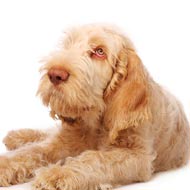New DNA test for cerebellar ataxia

CA is a serious neurological disease that causes the cerebellum - the part of the brain responsible for co-ordinating motor movement - to become diseased.
An official new DNA testing programme for cerebellar ataxia (CA) in Italian Spinoni has been approved by the Kennel Club.
CA is a serious neurological disease that causes the cerebellum - the part of the brain responsible for co-ordinating motor movement - to become diseased.
The new ‘linkage’ test relies on the link between the disease-causing gene and the nearby genes. By contrast, most DNA tests identify the particular genetic mutation that is known to cause the disease.
Sometimes, however, determining the mutation can be difficult. It is possible to infer the disease-causing variant - and therefore whether the animal is animal clear, a carrier, or affected by the disease - from the ‘linked’ variants nearby. Variants at genes near one another on the same chromosome are usually inherited together (i.e. linked).
Linkage tests are not as accurate as those where the actual causal variant is known. However, the Kennel Clubs says these tests can still be highly accurate and, therefore, predictive.
“Cerebellar ataxia is a very distressing, progressive condition,” said Kennel Club Secretary Caroline Kisko. “While this DNA testing programme for the condition is different to the DNA tests so far recorded by the Kennel Club, the programme could enable breeders to make sensible breeding decisions to eradicate this condition in Italian Spinoni so we would recommend utilising it to ensure a healthier future for this lovely breed.”
Health conditions with a linkage test will be either autumnal dominant or autosomal recessive. The breeding advice remains to same as for conditions with these modes of inheritance, though breeders should be aware that linkage tests are not always 100 per cent accurate. As a result the Kennel Club will not assign progeny as ‘hereditarily clear’. Results will only be recorded for individual dogs.



 The RCVS has announced a new version of its 1CPD mobile app, with enhanced features for veterinary surgeons and veterinary nurses to record their continuing professional development.
The RCVS has announced a new version of its 1CPD mobile app, with enhanced features for veterinary surgeons and veterinary nurses to record their continuing professional development.